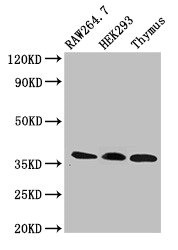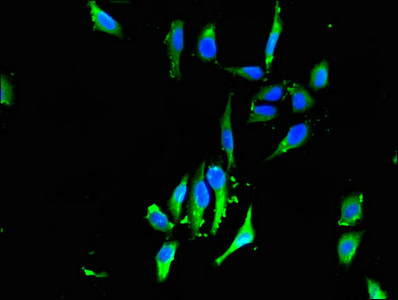Function
May have an involvement in muscle development or hypertrophy.
Gene References into Functions
- FHL1 increase inhibitory CDC25 phosphorylation by forming a complex with CHK2 and CDC25, and sequester CDC25 in the cytoplasm by forming another complex with 14-3-3 and CDC25, resulting in increased radioresistance in cancer cells. PMID: 28094252
- FHL1 promote paclitaxel resistance in hepatocellular carcinomas cells through regulating apoptosis induced by paclitaxel, suggesting that FHL1 may be a promising molecular target for Hepatocellular carcinoma therapy. PMID: 30249901
- Altogether, the specific localization of FHL1B and its modulation in disease-patient's myoblasts confirmed FHL1-related Emery-Dreifuss muscular dystrophy as a nuclear envelope disease. PMID: 27911330
- Low FHL1 expression is associated with head and neck squamous cell carcinoma. PMID: 26908444
- We have uncovered FHL1 as a novel potential regulator of calcium homeostasis in both fish and humans and have implicated it in isolated hypoparathyroidism. PMID: 28444561
- Mutations in FHL1 cause unclassifiable cardiomyopathy with coexisting Emery-Dreifuss muscular dystrophy. PMID: 26857240
- results provide evidence that FHL1A interacts with PLEKHG2 and regulates cell morphological change through the activity of PLEKHG2. PMID: 27765816
- a novel FHL1 splice site variant results in the absence of FHL1A and the abundance of FHL1C, which may contribute to the complex and severe phenotype of Uruguay syndrome. PMID: 26933038
- Knockdown of FHL1 with FHL1 small interfering RNA (siRNA) promoted tumor growth and Cyclin D and cyclin E were markedly elevated at both the protein and mRNA level. PMID: 26017856
- results indicate that anti-FHL1 autoantibodies in peripheral blood have promising potential as a biomarker to identify a subset of severe IIM. PMID: 26551678
- In healthy individuals, FHL1A is the predominant splice variant and is mainly found in skeletal and cardiac muscle. In two individuals with an Emery-Dreifuss plus phenotype with pulmonary artery hypoplasia and facial dysmorphology, there was demonstrated loss of isoform A and B, and an almost 200-fold overexpression of isoform C. PMID: 25724586
- FRG1 mice overexpressing FHL1 showed an improvement in the dystrophic phenotype PMID: 25695429
- FHL1 shRNA could significantly accelerate tumor cell growth via inhibiting the expression of FHL1 PMID: 26146054
- Our results suggest that miR-410 may function as an oncomiR and are consistent with its key function in regulating FHL1 in certain digestive system cancers. PMID: 25272045
- These data suggested that up-regulated FHL1 in smooth muscle in HSCR might be associated with intestinal wall remodeling in HSCR and might be one of the risk factors for gastrointestinal motor dysfunction PMID: 24516350
- This is the first study to show that FHL1 mutations identified in several clinically distinct myopathies lead to similar protein aggregation and impair myotube formation. PMID: 24634512
- The study has revealed that FHL1C overexpression induces Jurkat cell apoptosis. PMID: 24952875
- FHL-1 is the predominant complement regulator in Bruch's membrane having direct implications for age-related macular degeneration. PMID: 25305316
- Data indicate that four-and-a-half LIM domain 1 gene FHL1 mutation causing isolated hypertrophic cardiomyopathy with X-chromosomal inheritance. PMID: 24114807
- Data show that loss of FHL1 function leads to myopathy in vivo and suggest that loss of function of FHL1 may be one of the mechanisms underlying muscle dystrophy in patients with FHL1 mutations. PMID: 23975679
- mutation of FHL1 confers a complex phenotype through both gain- and loss-of-function mechanisms PMID: 23456229
- This study demonistrated that the expand the morphologic features of reducing body myopathy , clearly demonstrate the localization of FHL1 in skeletal muscles. PMID: 23965743
- FHL1 downregulation is associated with oral squamous cell carcinoma. PMID: 23123766
- FHL1 is a methylation-silenced tumor-suppressor gene on chromosome X in gastrointestinal cancers, and that its silencing contributes to the formation of an epigenetic field for cancerization. PMID: 22689052
- A mother, daughter, and son suffering from FHL1 myopathy have a mutation in the second LIM domain of fhl1 with musculoskeletal involvement. PMID: 22541254
- C224W mutation of FHLi protein had slightly elevated pulmonary artery pressure PMID: 22923418
- performed a clinical, muscle MRI, and histopathological characterization and immunoblot and genetic analysis of the FHL1 protein in a family with 4 individuals affected by reducing body myopathy. Identified a novel missense mutation in FHL1 PMID: 23169582
- FHL1 is a novel disease gene for hypertrophic cardiomyopathy. PMID: 22523091
- A novel mechanism involving four-and-a-half LIM domain protein-1 and extracellular signal-regulated kinase-2 regulates titin phosphorylation and mechanics. PMID: 22778266
- The decrease in or loss of FHL1 expression may be related to the incidence, progression, invasiveness, and metastatic potential of gastric cancer. PMID: 22143536
- reduced expression of FHL1 may play an important role in the development and progression of lung cancer. PMID: 21702045
- FHL1-3 inhibit HIF-1 transcriptional activity and HIF-1alpha transactivation domain function by oxygen-independent mechanisms. PMID: 22219185
- In order to substantiate a possible relation between K(v1.5) and FHL1C, a pull-down assay was performed. PMID: 22053194
- FHL-1 may regulate estrogen receptor signaling function through regulation of AKT activation besides the physical and functional interaction with Estrogen receptor alpha. PMID: 22094188
- FHL1 dystrophies are associated with myofibrillar myopathies pathology; mutations in the LIM2 domain are associated with reducing bodies composed of distinct tubulofilaments. PMID: 22094483
- We report on three British families with a heterogeneous myopathy clinical presentation segregating a single FHL1 gene mutation and haplotype, suggesting that this represents a founder mutation. PMID: 21629301
- This review will profile each of the FHL1, with a comprehensive analysis of mutations, a comparison of the clinical and histopathological features and will present several hypotheses for the possible disease mechanism(s)--{REVIEW} PMID: 21310615
- FHL1 protein expression is downregulated in thoracic aortic dissection. PMID: 21126853
- These results indicate that USP15 is involved in the regulation of hypertrophic responses in cardiac muscle through transcriptional and post-translational modulation of SLIM1. PMID: 21219870
- FHL1B/PP2A(Cbeta) interaction may illustrate a novel cell-cycle regulatory pathway. PMID: 20969868
- A novel missense mutation in the LIM2 domain of FHL1 co-segregated with X-linked scapuloperoneal myopathy in the family PMID: 20633900
- Expression levels of FHL1 mRNA increased in all cell lines tested, as shown by RT-PCR. The methylation index of FHL1 in our samples was significantly higher in 70 BC specimens than in 10 normal bladder epithelium specimens. PMID: 20596604
- This study reported a novel LIM2 domain mutation in FHL1 in a family with Reducing body myopathy with cytoplasmic bodies and spinal rigidity. PMID: 20571991
- Our finding expands the phenotypic spectrum of the recently identified FHL1-associated myopathies and widens the differential diagnosis of Emery-Dreifuss-like syndromes. PMID: 20186852
- SLIM1 may play an important role during the early stages of skeletal muscle differentiation, specifically in alpha5beta1-integrin-mediated signaling pathways PMID: 12917103
- FHL1 is a novel regulator of myosin-binding protein C activity that may have a role in sarcomere assembly PMID: 16407297
- Fasting insulin and insulin sensitivity index responses to exercise training were associated with DNA sequence variation in FHL1 in white men. PMID: 17589823
- These results characterize TLX1 as a dual function regulator whose activity in respect to FHL1 is critically dependent upon its cellular concentration, as well as cell type and promoter context. PMID: 18073142
- Study characterized a new disorder, X-linked myopathy with postural muscle atrophy (XMPMA), and identified FHL1 as the causative gene. PMID: 18179888
- In a large Italian-American pedigree with dominant Scapuloperoneal syndrome all of the affected individuals have a missense change (c.365G-->C) in the FHL1 gene encoding FHL1. PMID: 18179901
Show More
Hide All
Involvement in disease
Emery-Dreifuss muscular dystrophy 6, X-linked (EDMD6); Scapuloperoneal myopathy, X-linked dominant (SPM); Myopathy, X-linked, with postural muscle atrophy (XMPMA); Reducing body myopathy, X-linked 1A, severe, with infantile or early childhood onset (RBMX1A); Reducing body myopathy, X-linked 1B, with late childhood or adult onset (RBMX1B)
Subcellular Location
[Isoform 1]: Cytoplasm.; [Isoform 3]: Cytoplasm. Nucleus.; [Isoform 2]: Nucleus. Cytoplasm, cytosol. Note=Predominantly nuclear in myoblasts but is cytosolic in differentiated myotubes.
Tissue Specificity
Isoform 1 is highly expressed in skeletal muscle and to a lesser extent in heart, placenta, ovary, prostate, testis, small intestine, colon and spleen. Expression is barely detectable in brain, lung, liver, kidney, pancreas, thymus and peripheral blood le








